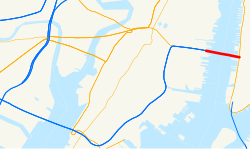Holland Tunnel

Manhattan entrance to tunnel, 1985
|
|
| Overview | |
|---|---|
| Official name | Clifford Milburn Holland Tunnel |
| Location | Jersey City, NJ–Lower Manhattan, New York City, NY, US |
| Route |
|
| Crosses | Hudson River |
| Operation | |
| Opened | November 13, 1927 |
| Operator | Port Authority of New York and New Jersey |
| Traffic | 93,356 (2010 AADT) |
| Toll | (eastbound only) As of December 6, 2015[update]; Cars $15.00 for cash, $12.50 for Peak (E-ZPass), $10.50 for Off-peak (E-ZPass) |
| Technical | |
| Length | 8,558 feet (2,608.5 m) (westbound) 8,371 feet (2,551.5 m) (eastbound) |
| No. of lanes | 4 |
| Tunnel clearance | 12.5 feet (3.81 m) |
| Width | ? |
| Depth of tunnel below water level | 93 feet (28.3 m) below MHW |
| Depth of shipping channel above | ? |
| Route map | |
|
Holland Tunnel
|
|
|
An eastbound trip through the tunnel
|
|
| Location | Jersey City, New Jersey and Manhattan, New York City |
| Built | 1920 |
| Architect | Clifford Holland |
| NRHP Reference # | 93001619 |
| Significant dates | |
| Added to NRHP | November 4, 1993 |
| Designated NHL | November 4, 1993 |
The Holland Tunnel is a highway tunnel under the Hudson River between Manhattan in New York City and Jersey City, New Jersey. Its two tubes carry eastbound and westbound Interstate 78. In New Jersey, it is also designated NJ 139. An integral conduit within the New York Metropolitan Area, it opened in 1927 as the first of two vehicular tunnels under the river, the other being the Lincoln Tunnel. Both are operated by the Port Authority of New York and New Jersey.
The tunnel was originally known as the Hudson River Vehicular Tunnel or the Canal Street Tunnel. It was renamed the Holland Tunnel in memory of Clifford Milburn Holland, the chief engineer, after his untimely death in October 27 1924, before the tunnel was approached. The innovative ventilation system was designed by Ole Singstad, who oversaw completion of tunnel's construction.
Begun in 1920 and completed in 1927, the tunnel is named after Clifford Milburn Holland (1883–1924), Chief Engineer on the project, who died before it was completed. Tunnel designer Ole Singstad finished Holland's work. The tunnel is first mechanically ventilated underwater vehicular tunnel in the world. Eighty-four fans, in four ventilation buildings, create a floor to ceiling air flow across the roadway at regular intervals, via systems of ducts beneath and above the roadway. The fans can completely change the air inside the tunnel every 90 seconds. A forced ventilation system is essential because of the poisonous carbon monoxide component of automobile exhaust, which constituted a far greater percentage of exhaust gases before catalytic converters became prevalent.
...
Wikipedia


